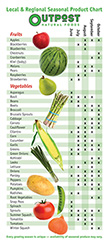Week 50 - Inspiration Comes In Many Forms

Week 50 - Inspiration Comes In Many Forms
A Year of InconvenienceFor one year, I'm making everything from scratch and forgoing convenience foods. Join me on my journey! By Pam Mehnert on April 11, 2011
.jpg) My inspiration in week 50 came in the form of two pretty amazing experiences. The first was the launch of my co-op’s new magazine, appropriately titled GRAZE. The second was a culinary trip to one of the newer Asian supermarkets in town called Pacific Coast. When I put the two amazing experiences together, it resulted in a batch of homemade kimchi, something I’ve never considered making before this.
My inspiration in week 50 came in the form of two pretty amazing experiences. The first was the launch of my co-op’s new magazine, appropriately titled GRAZE. The second was a culinary trip to one of the newer Asian supermarkets in town called Pacific Coast. When I put the two amazing experiences together, it resulted in a batch of homemade kimchi, something I’ve never considered making before this.
GRAZE is the inspiration of our fabulous marketing team at Outpost Natural Foods, and the very essence of what my co-op is all about. Subtitled, “around the kitchen table” GRAZE promises to tempt novice and experienced foodies alike with the products, flavors, and recipes of our amazing local artisans. The magazine, only available in our stores, is not supported by any outside advertising so that we could be sure and have the space to talk about the foods and vendors we love. The inspiration I drew upon this week was a recipe we published from local chef Jan Kelly from the restaurant Meritage. We gave Jan a challenge of one ingredient that she needed to design a meal around, and that was kimchi. Jan of course even made the kimchi from scratch, so I figured, why don’t I try?
 Making kimchi from scratch meant picking up some traditional flavors to stock up my pantry, which meant a trip to Pacific Coast. Now growing up as a child of the 60’s and 70’s, an Asian-inspired dinner at home usually meant chicken chow mein, often but not always from a can. I’m sure we had an Asian grocery store in town back then, small as it might have been, but my family would have never ventured to see it. I do however remember going to San Francisco for the first time, must have been around 1972, and my parent’s friends took us to Chinatown for dinner. My world of Asian flavors was expanded that night, not only on the streets and in the marketplace, but also at the dinner table. When I first heard about Kimchi a number of years ago what I heard was that it was some kind of pickled concoction of rotting food that was buried in a jar (yes, in the ground) for a year or so until it was ready to… um, eat. But if you search for it online you’ll see that it can be interpreted a number of different ways, everything from pasta sauce to pickles. Everyone has a different take on it and claims theirs is the best. At least that means it can be customized to include whatever your favorite vegetable or flavor. There were at least three very different looking varieties of kimchi offered fresh at Pacific Coast.
Making kimchi from scratch meant picking up some traditional flavors to stock up my pantry, which meant a trip to Pacific Coast. Now growing up as a child of the 60’s and 70’s, an Asian-inspired dinner at home usually meant chicken chow mein, often but not always from a can. I’m sure we had an Asian grocery store in town back then, small as it might have been, but my family would have never ventured to see it. I do however remember going to San Francisco for the first time, must have been around 1972, and my parent’s friends took us to Chinatown for dinner. My world of Asian flavors was expanded that night, not only on the streets and in the marketplace, but also at the dinner table. When I first heard about Kimchi a number of years ago what I heard was that it was some kind of pickled concoction of rotting food that was buried in a jar (yes, in the ground) for a year or so until it was ready to… um, eat. But if you search for it online you’ll see that it can be interpreted a number of different ways, everything from pasta sauce to pickles. Everyone has a different take on it and claims theirs is the best. At least that means it can be customized to include whatever your favorite vegetable or flavor. There were at least three very different looking varieties of kimchi offered fresh at Pacific Coast.
My first impression of Pacific Coast was that I had just stepped into the Mecca of Asian convenience foods. During the past 50 weeks of inconvenience I really haven’t been spending much time at all in the center aisles of any store, so it shouldn’t have been much of a surprise to me that foreign convenience foods would be so enticing. Freezer upon freezer was filled with noodles, pot stickers, buns, shumai dumplings, purple yams, mochi ice cream, and an inordinate amount of fish balls. Lisa began filling her shopping basket almost immediately in what appeared to be a convenience inspired food frenzy. Meanwhile I was having fun looking at all of the graphics and marketing ploys used to sell products to people of different cultures, knowing how easily it is to buy into the kitsch of it all. Yes, we came home with the giant tin of cream crackers (perfectly toasted and flaky like a pie crust), rice crackers, udon noodles, as well as the ingredients needed for my kimchi. Heck, I could easily be eating those convenience foods in just two short weeks from now, if there is any left that is.
So I started the kimchi that afternoon, before leaving town for a week on business. That meant Lisa would finish making the kimchi as the first step was to let the cabbage tossed with salt and sugar, sit overnight in the refrigerator. She said that she modified the recipe somewhat, using two carrots and grating them instead of julienne, and using a little less chili powder not knowing how potent it was going to be. The size of the cabbage will definitely determine the yield, our batch made about a quart.
I’m really looking forward to getting home from this business trip I’m on, so I can try it on a grilled pork or chicken taco, or with fish as chef Jan had prepared. Do share your kimchi experiences with me, I’d really love to learn more about it.
 Refrigerator Kimchi (from Jan Kelly, chef and owner of Meritage Restaurant)
Refrigerator Kimchi (from Jan Kelly, chef and owner of Meritage Restaurant)
1 head Napa cabbage
2 tablespoons Kosher salt
½ cup sugar plus two tablespoons
3 tablespoons chopped garlic
3 to 4 tablespoons chopped ginger
¼ cup soy sauce
¼ cup fish sauce
½ cup Asian chili powder
2 teaspoons salted shrimp (in a jar)
½ cup julienned carrots (optional)
½ cup sliced green onions (optional)
Water if needed
- Cut the cabbage in half then cut crosswise into one-inch pieces.
- Toss cabbage with salt and two tablespoons sugar and let it sit overnight in the refrigerator.
- Make the bring: combine the garlic, ginger, Asian chili powder, fish sauce, soy sauce, shrimp, and ½ cup sugar. The consistency will be like creamy dressing. If it’s too thick, add a little water.
- Add the carrots and green onions to the brine if using.
- Drain any water off the cabbage and add it to the brine. Make sure and coat it really well.
- Cover and/or store in jars in your refrigerator. Let it sit for at least 24 hours before using. The longer it sits, the stronger the flavor, so keep trying it until you find the flavor that you like.
We used less hot pepper and it was still plenty zesty. We also cut back on the soy sauce and fish sauce because both are quite salty. That’s the beauty of kimchi, it’s infinitely customizable to your taste!
Comments
Bloggers
Archived Columns
Tags
Archives
-
April 2024 (1)
March 2024 (1)
February 2024 (1)
December 2023 (1)
August 2023 (1)
March 2023 (1)
February 2023 (1)
November 2021 (1)
September 2021 (1)
November 2020 (1)
October 2020 (1)
July 2020 (1)
June 2020 (1)
May 2020 (1)
February 2020 (1)
January 2020 (1)
December 2019 (1)
November 2019 (1)
October 2019 (1)
August 2019 (2)
May 2019 (1)
March 2019 (2)
January 2019 (1)
December 2018 (1)
November 2018 (1)
October 2018 (2)
September 2018 (1)
February 2018 (1)
November 2017 (2)
October 2017 (1)
July 2017 (2)
March 2017 (1)
February 2017 (1)
January 2017 (1)
December 2016 (2)
November 2016 (1)
August 2016 (2)
July 2016 (2)
March 2016 (2)
February 2016 (2)
January 2016 (1)
December 2015 (1)
October 2015 (3)
August 2015 (1)
July 2015 (2)
June 2015 (1)
March 2015 (2)
February 2015 (2)
January 2015 (2)
December 2014 (2)
November 2014 (1)
October 2014 (3)
August 2014 (2)
July 2014 (1)
June 2014 (2)
May 2014 (2)
April 2014 (1)
March 2014 (2)
February 2014 (2)
January 2014 (2)
December 2013 (1)
November 2013 (2)
October 2013 (1)
July 2013 (2)
June 2013 (1)
May 2013 (2)
April 2013 (1)
March 2013 (2)
February 2013 (1)
January 2013 (2)
December 2012 (3)
November 2012 (1)
October 2012 (3)
September 2012 (2)
August 2012 (4)
July 2012 (4)
June 2012 (6)
May 2012 (3)
April 2012 (4)
March 2012 (6)
February 2012 (8)
January 2012 (3)
December 2011 (4)
October 2011 (4)
September 2011 (3)
August 2011 (5)
July 2011 (7)
June 2011 (1)
May 2011 (2)
April 2011 (7)
March 2011 (10)
February 2011 (12)
January 2011 (11)
December 2010 (19)
November 2010 (13)
October 2010 (22)
September 2010 (16)
August 2010 (24)
July 2010 (33)
June 2010 (5)
May 2010 (52)
April 2010 (37)
March 2010 (55)
February 2010 (44)
January 2010 (46)
December 2009 (40)
November 2009 (26)
October 2009 (37)
September 2009 (34)
August 2009 (24)
July 2009 (21)
June 2009 (29)
May 2009 (30)
April 2009 (33)
March 2009 (16)
February 2009 (2)
January 2009 (5)
November 2008 (1)
October 2008 (1)
September 2008 (2)
August 2008 (3)
July 2008 (2)
June 2008 (6)
May 2008 (2)
April 2008 (10)
March 2008 (5)
February 2008 (5)
January 2008 (12)
December 2007 (5)
October 2007 (3)
August 2007 (3)
July 2007 (1)
June 2007 (5)
May 2007 (4)
April 2007 (6)
March 2007 (3)
February 2007 (3)
January 2007 (4)
December 2006 (2)
October 2006 (2)
September 2006 (5)
August 2006 (8)
0 (1)










